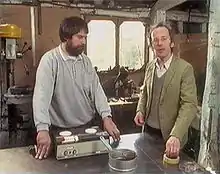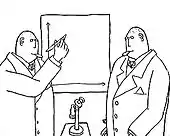The Secret Life of Machines
The Secret Life of Machines is an educational television series presented by Tim Hunkin and Rex Garrod, in which the two explain the inner workings and history of common household and office machinery.[1] According to Hunkin, the show's creator, the programme was developed from his comic strip The Rudiments of Wisdom, which he researched and drew for the Observer newspaper over a period of 14 years. Three separate groupings of the broadcast were produced and originally shown between 1988 and 1993 on Channel 4 in the United Kingdom, with the production subsequently airing on The Learning Channel and the Discovery Channel. [2][3][4][5]
| The Secret Life of Machines | |
|---|---|
 Garrod (left) and Hunkin (right) demonstrating how to make "audio tape" from sticky tape and powdered rust | |
| Genre | Educational |
| Created by | Tim Hunkin |
| Developed by | Tim Hunkin |
| Written by | Tim Hunkin |
| Directed by |
|
| Presented by | Tim Hunkin |
| Starring | |
| Narrated by | Tim Hunkin |
| Theme music composer | Val Bennett |
| Opening theme | The Russians are Coming (a cover of Take Five) |
| Ending theme | The Russians are Coming |
| Country of origin | United Kingdom |
| Original language | English |
| No. of series | 3 |
| No. of episodes | 18 |
| Production | |
| Producer | Elizabeth Queenan |
| Production locations | Lowestoft, Suffolk, England, United Kingdom |
| Cinematography | Mike Coles |
| Editor | Peter Cox |
| Camera setup | Multi-camera |
| Running time | 25 minutes |
| Production company | Artifax |
| Release | |
| Original network | Channel 4 |
| Picture format | PAL (576i) |
| Audio format | Monaural |
| External links | |
| The Secret Life of Machines | |
Contents
Each of the Secret Life's individual series covers a particular set of machines. The first addresses household appliances, while the second includes devices used outside the home, such as the car. The third series examines the contraptions and gadgets used in a modern office.

Each episode was given an individual title, such as The Secret Life of the Vacuum Cleaner. Although ostensibly about a specific appliance or piece of technology, the scope of each episode was often widened to cover related technologies as well. For example, the video recorder episode looked at magnetic recording from its origins, and featured Hunkin and Garrod recording their voices on a crude home-made "audio tape" consisting of rust-coated sticky tape.
Another aspect of the programmes was their use of humorous animations based on Hunkin's own drawings. These cartoons were often based around the historical figures involved in the development of a particular technology. Furthermore, the illustrations were an artistic commentary on modern society, including segments on lift fantasies (as shown in the episode "The Lift") and corporate disregard for individuals' rights (featured in many episodes, including "The Radio" and "The Car").
Each programme concluded with an epilogue consisting of an elaborate installation, which resembled an aspect of the machine or technology under discussion. One example was a giant statue resembling a robot, which had been built from scrap computer monitors, printers and other parts, which was blown up using pyrotechnics. Hunkin described the destruction as an allegorical point that computers are just a collection of transistors and lack "superhuman intelligence".
Production
All the series used animation to help explain various aspect of how the subject devices function. The animation for the series was done by Hunkin himself in a uniquely recognisable format.
Episode list
Series 1 (1988)
The first series covers household appliances.
| No | Ep | Title | Original air date | |
|---|---|---|---|---|
| 1 | 1 | "The Secret Life of the Vacuum Cleaner" | 15 November 1988 | |
|
Explores how a vacuum cleaner functions. Epilogue: Various vacuums fitted with pyrotechnics fly from a pile, guided by wires, with sparks streaming from the rear like a rocket. Historical Figures Mentioned: Hubert Cecil Booth, James M. Spangler, William H. Hoover | ||||
| 2 | 2 | "The Secret Life of the Sewing Machine" | 22 November 1988 | |
|
Explores how a sewing machine functions. Epilogue: A modern sewing machine is shown embroidering "THIS IS THE END ** GOODBYE" on a piece of fabric. Historical Figures Mentioned: Thomas Saint, Barthélemy Thimonnier, Walter Hunt, Elias Howe, Isaac Merritt Singer, Edward Cabot Clark | ||||
| 3 | 3 | "The Secret Life of the Central Heating System" | 29 November 1988 | |
|
Explores how a central heating system functions. Epilogue: A life-size model of a central heating system, used during the show, begins to spray water everywhere. Historical Figures Mentioned: Ancient Romans, Normans, Lord Burlington, Robert Bunsen | ||||
| 4 | 4 | "The Secret Life of the Washing Machine" | 6 December 1988 | |
|
Explores how a washing machine functions. Epilogue: A pyramid of washing machines is switched onto spin cycle whilst Hunkin talks about recent developments | ||||
| 5 | 5 | "The Secret Life of the Refrigerator" | 13 December 1988 | |
|
Explores how a refrigerator functions. Epilogue: Multiple refrigerators are made to dance around using stop motion animation | ||||
| 6 | 6 | "The Secret Life of the Television Set" | 20 December 1988 | |
|
Explores how a television functions. Epilogue: A mountain of television sets are burned in a massive bonfire whilst still switched on | ||||
Series 2 (1991)
In the second group of programmes, devices used outside the home are investigated. The first two episodes are closely related, both dealing with the car and similar vehicles.
| No | Ep | Title | Original air date | |
|---|---|---|---|---|
| 7 | 1 | "The Secret Life of the Car" | 8 January 1991 | |
|
Explores how a car functions. This episode covers the body/chassis component only. Epilogue: The bodyshell of a Ford Cortina is cubed in a car crusher | ||||
| 8 | 2 | "The Secret Life of the Internal Combustion Engine" | 15 January 1991 | |
|
Explores how an internal combustion engine functions. Epilogue: A running engine is carried to the centre of a "carhenge"—a replica of Stonehenge made entirely of car bodies—by several men in white coveralls | ||||
| 9 | 3 | "The Secret Life of the Quartz Watch" | 22 January 1991 | |
|
Explores how a quartz watch functions. Epilogue: Tim Hunkin's closing narration is interrupted when an oven in the background bursts open, followed by a sped up and reversed recording of a watch in said oven baked to destruction | ||||
| 10 | 4 | "The Secret Life of the Telephone" | 29 January 1991 | |
|
Explores how a telephone functions. Epilogue: Stop motion animation of various novelty phones dancing across a stage | ||||
| 11 | 5 | "The Secret Life of the Radio Set" | 5 February 1991 | |
|
Explores how a radio functions. Epilogue: Multiple radios (which have been converted into remote-control cars) are driven around, sometimes colliding into one another | ||||
| 12 | 6 | "The Secret Life of the Video Recorder" | 12 February 1991 | |
|
Explores how a video recorder functions. Epilogue: Scrap video recorders are arranged to spell out "THE END." The camera then zooms out, revealing Tim watching a recorded version of the epilogue. | ||||
Series 3 - The Secret Life of the Office (1993)
The third and final series concentrated on office-related technology. It also introduced an animated set of fictional characters who worked in the offices of the fictional Utopia Services company.
| No | Ep | Title | Original air date | |
|---|---|---|---|---|
| 13 | 1 | "The Secret Life of the Lift" | 18 February 1993 | |
|
Explores how a lift functions. Epilogue: Hunkin is "blasted" into the sky in a lift car powered by rocket motors | ||||
| 14 | 2 | "The Secret Life of the Word Processor" | 25 February 1993 | |
|
Explores how a word processor functions. This programme used its core subject as the basis for a look at many significant technologies surrounding modern computer systems, e.g. the typewriter. Epilogue: A giant robot-shaped frame covered in computers bursts into flames sending the computers tumbling to the ground | ||||
| 15 | 3 | "The Secret Life of the Electric Light" | 4 March 1993 | |
|
Explores how an electric light functions. Epilogue: As the camera is lifted into the sky on a crane, what seems at first to be randomly placed house lighting is gradually revealed to actually spell out "THE END" | ||||
| 16 | 4 | "The Secret Life of the Photocopier" | 11 March 1993 | |
|
Explores how a photocopier functions. Epilogue: Tim Hunkin is revealed to be sitting on top of a mountain of shredded paper at a recycling centre, followed by video of him using a bulldozer to drive through the pile | ||||
| 17 | 5 | "The Secret Life of the Fax Machine" | 18 March 1993 | |
|
Explores how a fax machine functions. Epilogue: While testing out his home built model of a Pantelegraph, it begins to smoke and finally explodes | ||||
| 18 | 6 | "The Secret Life of the Office" | 25 March 1993 | |
|
Explores how an office functions. The final "Secret Life" programme broadcast, this episode covered not just physical technologies, but also the evolution of social engineering involved in the running of an office. Epilogue: An office goes haywire, blowing paper everywhere, shaking binders and everything generally moving with a will of its own. After the chaos winds down, Tim Hunkin cautiously emerges from under a desk | ||||
Creative uses
Hunkin and Garrod used the series to show some of their devices they built from parts of machines featured on their programme. The creations, some of which were decorative, others functional, show the potential uses of broken machinery. An extreme example is the giant clock powered by steam.[6]
Availability
The series was released on video tape and DVD. It subsequently became available on online streaming sites on the Internet.
Tim Hunkin himself encourages others to download the series from a number of nominated websites.[7]
References
- Woods, Sarah (20 May 2004). "Tim's weird and wonderful experiments". Richmond and Twickenham Times. Weybridge, England, United Kingdom. ISSN 1758-9304. OCLC 500308012. Retrieved 4 March 2012.
- Harvey, Robin (27 May 1995). "Practical TV crafts entertain". Toronto Star. Toronto, Ontario, Canada: John Cruickshank. p. H2. ISSN 0319-0781. OCLC 137342540. Retrieved 4 March 2012.
- "Critic's Choice". Minneapolis Star-Tribune. Minneapolis, Minnesota, US: Michael J. Klingensmith. 26 January 1993. ISSN 0895-2825. OCLC 61312696.
- Werts, Diane (15 May 2004). "OFF THE WALL". Newsday. Melville, New York, US: Fred Groser. p. C01. ISSN 0278-5587. OCLC 5371847.
- Barnhart, Aaron (21 May 2004). "Sweeps wind down with a few fresh shows". The Kansas City Star. Kansas City, Missouri, US: Mi-Ai Parrish. p. E9. ISSN 0745-1067. OCLC 3555868.
- Hunkin, Tim (2012). "tim hunkin/giant steam clock". timhunkin.com. Tim Hunkin. Retrieved 4 March 2012.
- Hunkin, Tim (2012). "secret life of machines 1". timhunkin.com. Tim Hunkin. Retrieved 4 March 2012.